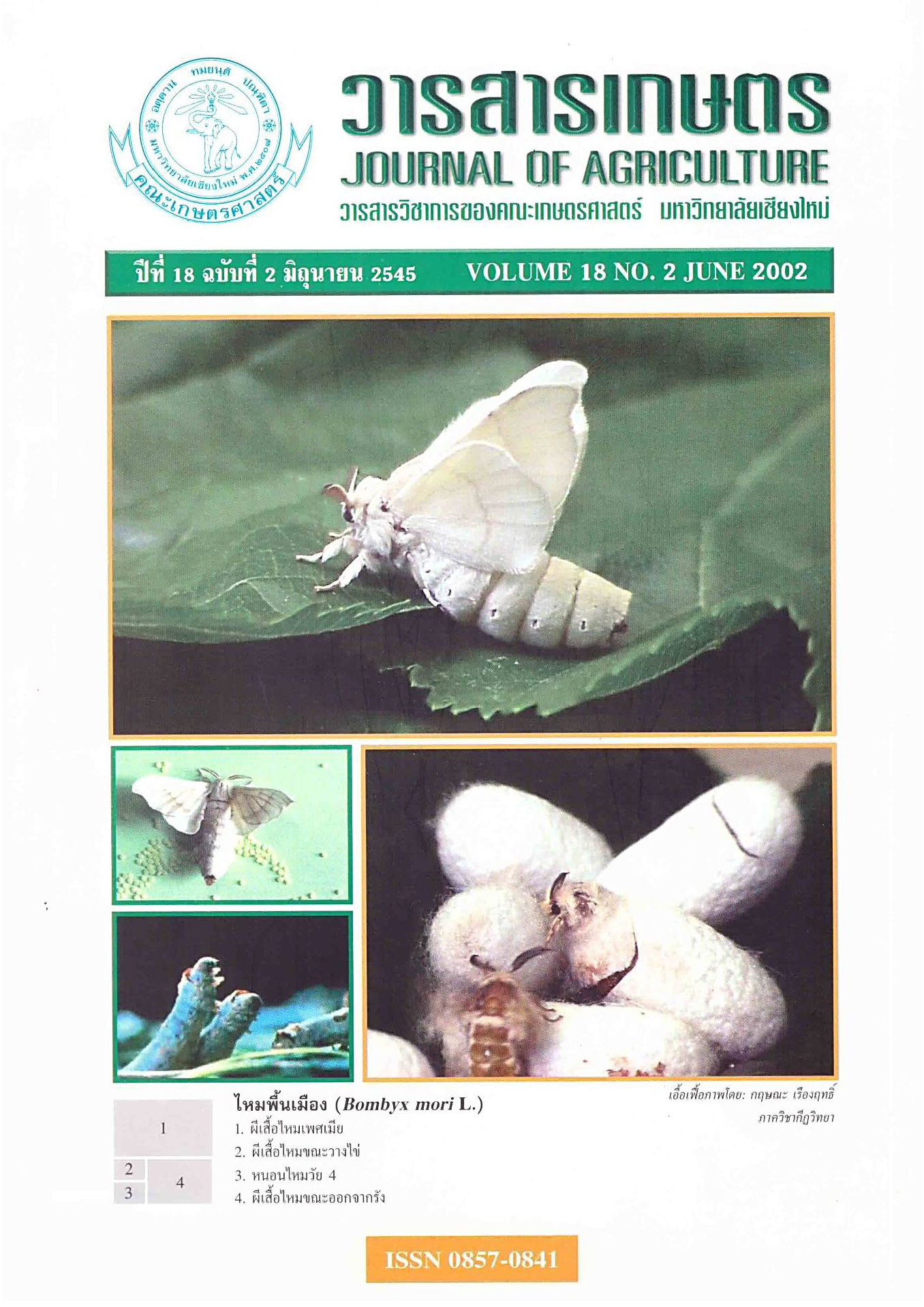ผลของเอทธานอลและอะซีตัลดีไฮด์ต่อการควบคุม โรคเน่าราสีเขียวและคุณภาพของผลส้มเขียวหวาน
Main Article Content
บทคัดย่อ
การศึกษาผลของการใช้เอทธานอล และอะซีตัลดีไฮด์ควบคุมโรค โดยวิธีการรมด้วยไอระเหยของสาร ผลการทดลองแสดงว่าความเข้มข้นของเอทธานอล และระยะเวลาการรมที่ต่างกันมีผลต่อการควบคุมโรคเน่าราสีเขียว และความผิดปกติบนผลส้ม เอทธานอลสามารถยับยั้งการเจริญของเชื้อรา Penicillium sp. ได้โดยไม่ทำให้เกิดอาการผิดปกติกับผลส้ม การรมด้วยไอระเหยของเอทธานอลที่ความเข้มข้น 0.05 เปอร์เซ็นต์นาน 3 วัน สามารถชะลอการเกิดโรคได้นาน 4.25 วัน ในขณะที่รมด้วยไอระเหยของอะซีตัลดีไฮด์ ที่ความเข้มข้น 0.01 เปอร์เซ็นต์ สามารถชะลอการเกิดโรคได้นาน 2.63 วัน เมื่อวิเคราะห์องค์ประกอบทางเคมีของผลส้ม แสดงว่า เอทธานอลและอะซีตัลดีไฮด์ ไม่มีผลกระทบต่อปริมาณกรดแอสคอร์บิค ปริมาณของแข็งที่ละลายน้ำได้ และปริมาณกรดที่ไตเตรทได้ แต่มีผลต่อการเปลี่ยนแปลงสีผิวของผลส้ม
Article Details
เอกสารอ้างอิง
ดนัย บุณยเกียรติ. 2543. โรคหลังเก็บเกี่ยวพืชสวน. ภาควิชาพืชสวน คณเกษตรศาสตร์ มหาวิทยาลัยเชียงใหม่ , เชียงใหม่.156 หน้า.
ดนัย บุณยเกียรติ และนิธิยา รัตนาปนนท์. 2535. การปฏิบัติหลังการเก็บเกี่ยวผักและผลไม้. สำนักพิมพ์ โอเดียนสโตร์กรุงเทพฯ. 146 หน้า.
วิกันดา คงสวัสดิ์, 2541. ผลของการใช้สีสกัดธรรมชาติ และสารเคลือบผิวต่อคุณภาพของผลส้มเขียวหวานหลังการเก็บเกี่ยว. วิทยานิพนธ์ปริญญาโท คณะเกษตรศาสตร์ มหาวิทยาลัยเชียงใหม่ 148 หน้า.
Anonymous. 1988. Effect of acetaldehyde vapours or anaerobic conditions prior to storage on postharvest quality of citrus fruits. Citricculture. 6th International Citrus congress, Middle- East, Tel Aviv, Israel, 6-11 March 1988. Volume 3. pp. 1393-1399.
Davies, F. S. and L. G. Albrigo. 1994. Citrus. CAB International., Wallingford, Oxon, UK.254 p. Eckert, J. W., J. R. Sievert and M. Ratnayake. 1994. Reduction of imazalil effectiveness against citrus green mold in California packinghouse by resistant biotype of Penicillium digitatum.Plant Dis. 78: 971-974.
Hagenmaier, R. D. 2002. The flavor of mandarin hybrids with different coatings. Postharvest Biology and Technology 24 : 79-87.
Kale, P. N. and P. G. Adsule. 1995. Citrus. Handbook of Fruit Science and Technology. Edited by Salunkhe D.K. and S.S. Kadam. Marcel Dekker, Inc. N.Y. 611 p.
Morris, J. R., D. L. Cawthon and R. W. Buescher, 1979. Effect of acetaldehyde on postharvest quality of mechanically harvested strawberries for processing. J. Amer. Soc. Hort. Sci. 104 (2) : 262-264.
Pez, O., H. Janes, B. Prevost and C. Frenkel. 1982. Enhancement of fruit sensory quality of postharvest applications of acetaldehyde and ethanol. J. of Food Science 47: 270-276.
Smilanick, J.L., D.A. Margosan and D.J. Henson. 1995. Evaluation of heated solution of sulfurdioxide, ethanol, and hydrogen peroxide to control postharvest green mold of lemons. Plant Dis. 79 : 742-747.
Stadelbacher, G.J. and K. Prasad. 1974. Postharvest decay control of apple by acetaldehyde vapor. J. Amer. Soc. Hort. Sci. 99(4) : 364-368.
Ting, S. V. and J. A. Attaway. 1971. Citrus Fruits. pp. 107-169. In A. C. Hulme (ed.). The Biochemistry of Fruit and Their Products. Vol. 2. Academic Press, London.
Yuen, C. M. C., J. E. Paton, R. Hanawati and L. Q. Shen. 1995. Effects of ethanol, acetaldehyde and ethyl formate vapour on the growth of Penicillium italicum and P. digitatum on oranges. J. Hort. Sci. 70 (1): 81-84.


